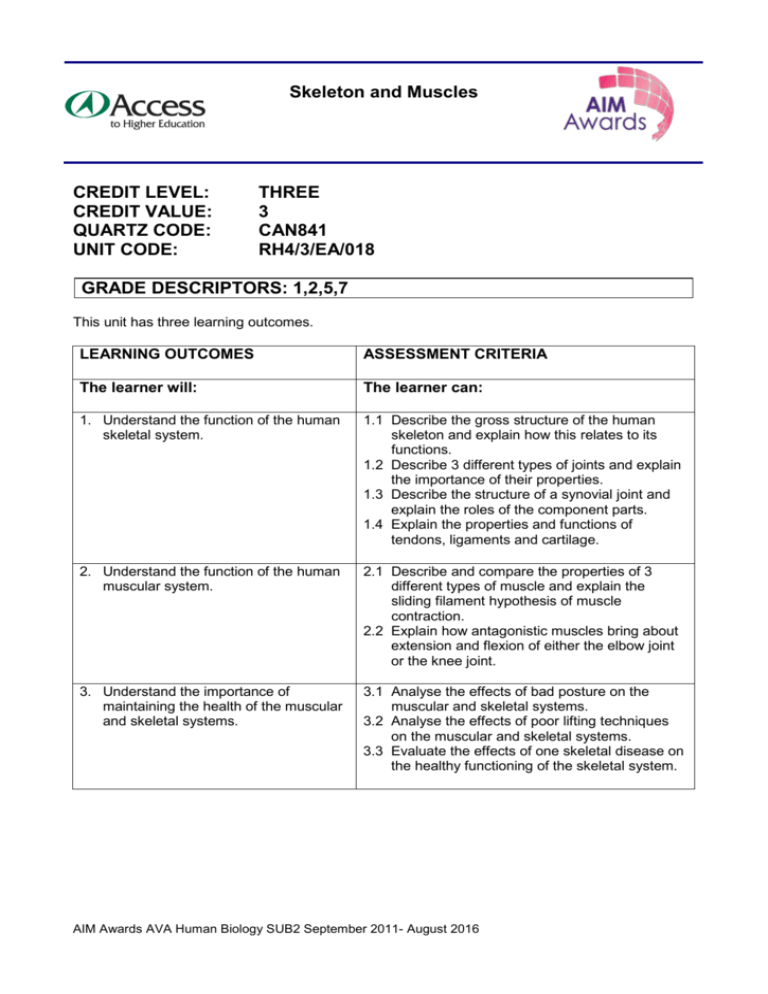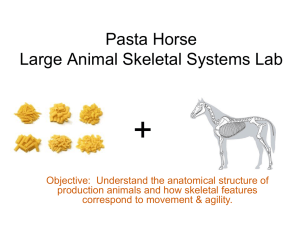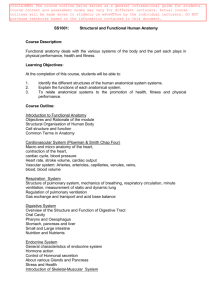Skeleton and Muscles: Human Biology Learning Unit
advertisement

Skeleton and Muscles CREDIT LEVEL: CREDIT VALUE: QUARTZ CODE: UNIT CODE: THREE 3 CAN841 RH4/3/EA/018 GRADE DESCRIPTORS: 1,2,5,7 This unit has three learning outcomes. LEARNING OUTCOMES ASSESSMENT CRITERIA The learner will: The learner can: 1. Understand the function of the human skeletal system. 1.1 Describe the gross structure of the human skeleton and explain how this relates to its functions. 1.2 Describe 3 different types of joints and explain the importance of their properties. 1.3 Describe the structure of a synovial joint and explain the roles of the component parts. 1.4 Explain the properties and functions of tendons, ligaments and cartilage. 2. Understand the function of the human muscular system. 2.1 Describe and compare the properties of 3 different types of muscle and explain the sliding filament hypothesis of muscle contraction. 2.2 Explain how antagonistic muscles bring about extension and flexion of either the elbow joint or the knee joint. 3. Understand the importance of maintaining the health of the muscular and skeletal systems. 3.1 Analyse the effects of bad posture on the muscular and skeletal systems. 3.2 Analyse the effects of poor lifting techniques on the muscular and skeletal systems. 3.3 Evaluate the effects of one skeletal disease on the healthy functioning of the skeletal system. AIM Awards AVA Human Biology SUB2 September 2011- August 2016 Skeleton and Muscles CREDIT LEVEL: CREDIT VALUE: QUARTZ CODE: UNIT CODE: THREE 3 CAN841 RH4/3/EA/018 GRADE DESCRIPTORS: 1,2,5,7 ASSESSMENT INFORMATION Step One: Assessment of learning outcomes via assessment criteria: This grid gives details of the assessment activities to be used with the unit. Please refer to the AIM Awards AVA Access to HE Manual for definitions of each activity and the expectations for assessment practice and evidence for moderation. The assessment activities for this unit are indicated in the table below: Key: P = Prescribed – this assessment method must be used to assess the unit. O = Optional – this assessment method could be used to assess the unit. Case study O Project Written question & answer/test/exam Essay O Role play/simulation O O Practical demonstration O Written Report O Group discussion Oral question and answer O Performance/exhibition Written description O Production of artefact Reflective log / diary O Practice file Presentation Step Two: Grading • Meets assessment criteria but not merit descriptors. Pass awarded. • Meets assessment criteria & merit but not distinction descriptors. Merit awarded. • Meets assessment criteria and distinction descriptors. Distinction awarded. For guidance on grading please refer to the QAA: Grades and the Access to HE Diploma: Implementation Manual. www.accesstohe.ac.uk AIM Awards AVA Human Biology SUB2 September 2011- August 2016











